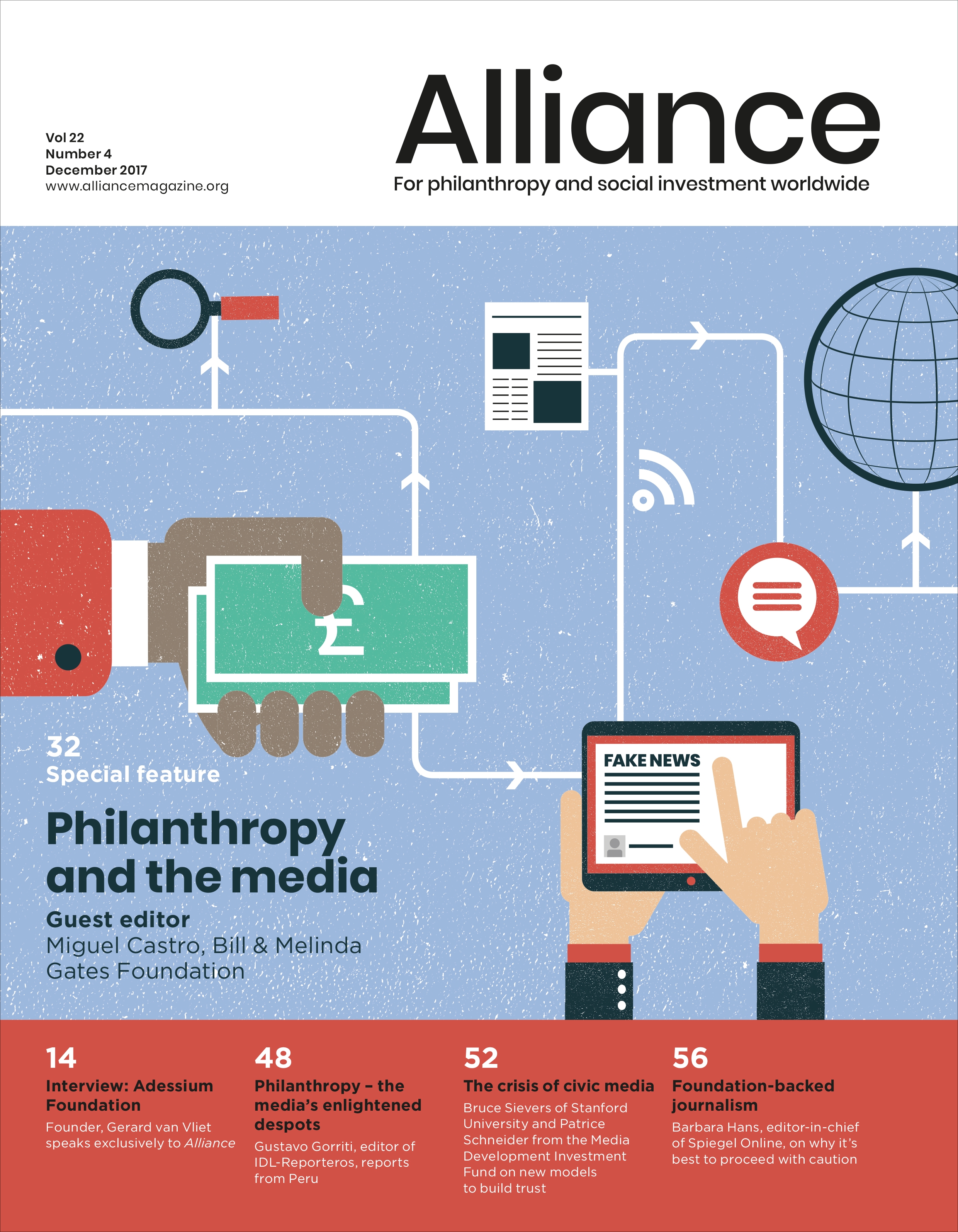Philanthropies now support media and journalism to a spectacular degree – some $1.3 billion annually between 2011 and 2015, a stunning amount by news industry standards.
The authoritative source on the matter, the Media Grants Data Map maintained by Media Impact Funders and the Foundation Center, indicates how charitable foundations distribute this bounty.
More than two-thirds goes towards what could be described as services: awareness campaigns for social or other charitable causes (including international development), education, or otherwise information-oriented platforms. Another fifth is awarded to the thematic cluster of press freedom, open access and technological innovation in media.
That leaves on average just 17 per cent of the available funding for journalism in the narrower sense, that is, the production of independent journalistic coverage.
In absolute figures, this translates into journalism grants worth more than $220 million each year – even more if we account for European and other journalism grantmaking worldwide that has not made it into the Media Grants Data Map yet. A recent study commissioned by the European Journalism Centre revealed that the UK market alone is estimated at close to $40 million annually.
Two reasons why the US gets the biggest share
And yet, charitable journalism funding largely remains a US affair – both in terms of donors and beneficiaries. More than 90 per cent of grant money flows to US-based organizations, with some 6 per cent of funds allocated to Europe, and only about 1 per cent to media outlets in the developing world.
The vast majority of foundations engaging in the sector are also based in the US. The reasons are two-fold. First, Europe has generally a less-developed philanthropy culture than the US. Second, it traditionally has strong public- or state-funded media and far-ranging media subsidy systems in place.
More than 90 per cent of grant money flows to US-based organizations, with some 6 per cent of funds allocated to Europe, and only ab out 1 per cent to media outlets in the developing world.
Hence, potential donors habitually do not perceive media and journalism as particularly in need of extra funding, but rather focus their efforts on social issues, science and the arts. This may have changed recently, though – there is a noticeable European equivalent to the ‘Trump bump’ reported by ProPublica.
Like goes to like
Non-profit recipients attract the better part of journalism-related grant revenues; less than 3 per cent of the total grants budget is funnelled directly into commercial news organizations.
That figure is higher, though, if sub-grants made by non-profit intermediaries such as the European Journalism Centre are counted. Indeed, existing rules and regulations make it more difficult for charitable foundations to subsidize businesses than to fund fellow charities. Keeping the money within the tax-exempt ecosystem is the path of least resistance.
That said, the mutual reservations between foundations and commercial news outlets also indicate that their interests are not always perfectly aligned.
Foundations often see media and journalism as proxies of their own issue-driven campaigning. Catering to this demand comes naturally to similarly inclined NGOs, but not to general-purpose journalism organizations.
The mutual reservations between foundations and commercial news outlets also indicate that their interests are not always perfectly aligned.
What the latter rather hope for is that foundations ‘embrace the model of journalism’, as one participant in the European Journalism Centre’s Journalism Funders Forum put it: journalism in the public interest as a purpose in and of itself.
Nevertheless, it should be noted that thematically targeted foundation funding, such as the Bill & Melinda Gates Foundation’s international support for development coverage, still goes a long way towards supporting a healthy news ecosystem as a whole.
Where issue-driven funders respect editorial independence, they enable quality journalism and give a boost to journalistic talent in a way that the ailing industry itself is increasingly unlikely to afford.
Between 2011 and 2014, just 7 per cent of funding went into unrestricted operational support for journalism organizations (not counting expenses for the Newseum in Washington, which is the single largest recipient of philanthropic journalism funding at an accumulated $231 million – ten times as much as ProPublica).
The John S and James L Knight Foundation and the Ford Foundation are among the main donors in this space, helping organizations such as ProPublica, the Center for Investigative Reporting, and the Center for Public Integrity to perform their work independently and shielding them from the whims of the market.
Finally, this trend has also caught on in Europe. In Germany, the Brost Foundation has made a substantial investment into Correctiv, which could be described as the German ProPublica, and Schöpflin Foundation has pledged almost $30 million to the creation of a future House of Non-Profit Journalism.
In the UK, the Centre for Investigative Journalism and the Bureau for Investigative Journalism have received grants from, among others, the David and Elaine Potter Foundation, the Dutch Stichting Democratie en Media, and Adessium Foundation.
Even inside the bloc of the European Union, most funding opportunities remain tied to domestic interests, although funders from the Netherlands in particular distinguish themselves by making cross-border grants.
Finally, one of the most remarkable aspects of this new development is that an increasing number of foundations without a background in news are coming into the picture.
While unconditional journalism funding used to emerge almost exclusively from donors fuelled by old newspaper money (Knight and Brost are examples), the times are such that foundations with different backgrounds now come to appreciate the public value that lies in independent journalism, too.
A great opportunity – but one for which journalism must step up to the plate as well.
Eric Karstens is a grant consultant for the European Journalism Centre and other clients. Email karstens@ejc.net
The author thanks Sarah Armour-Jones and Media Impact Funders for access to their database and valuable advice. All figures are based on the author’s own calculations.




Comments (0)